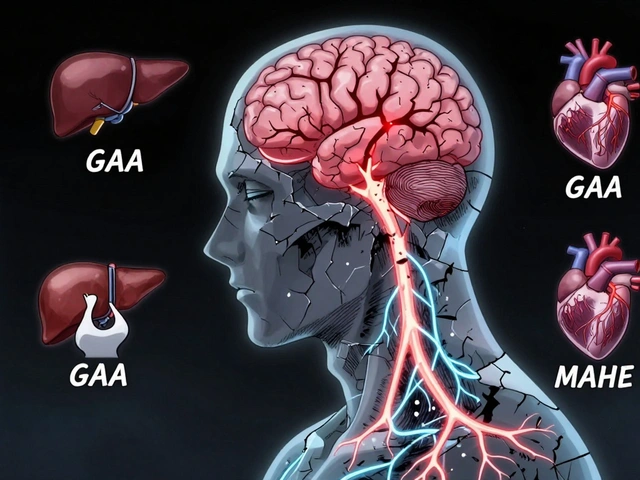Weight‑Loss Medication Matcher
Contrave is a prescription combo of naltrexone and bupropion approved for chronic weight management in adults with a BMI≥30 or≥27 with weight‑related conditions. When it comes to weight‑loss drugs, Contrave stands out because it targets both appetite and reward pathways, but it’s not the only option on the market. This guide breaks down how it stacks up against the most commonly prescribed alternatives, helping you decide which medication aligns with your lifestyle, health profile and budget.
Key Takeaways
- Contrave works by modulating brain signals that control hunger and cravings.
- Orlistat blocks fat absorption, while Phentermine stimulates the central nervous system.
- GLP‑1 agonists such as Liraglutide and Semaglutide offer the highest average weight loss but require injection.
- Safety profiles differ: Contrave may raise blood pressure; Orlistat can cause oily stools; GLP‑1 drugs often cause nausea.
- Cost, insurance coverage and BMI eligibility are decisive factors in real‑world prescribing.
Understanding Contrave’s Core Ingredients
Naltrexone is an opioid‑receptor antagonist that, at low doses, dampens the reward response to food (reducing cravings for high‑calorie, palatable foods). It’s traditionally used to treat alcohol and opioid dependence, but in the Contrave formula it plays a supportive role.
Bupropion is an atypical antidepressant that also acts as a norepinephrine‑dopamine reuptake inhibitor (boosting satiety and energy expenditure). In combination, the two drugs create a synergistic effect on appetite control.
Clinical trials (e.g., the COR‑I and COR‑II studies) showed an average 5-10% body‑weight reduction after one year when paired with diet and exercise. The FDA approved Contrave in 2014 for the UK market, making it one of the few oral weight‑loss combos available.
Big Players in the Weight‑Loss Landscape
Below are the main competitors you’ll encounter in a typical NHS or private‑prescription setting.
Orlistat is a lipase inhibitor that prevents about 30% of dietary fat from being absorbed (acting in the gut). It’s sold over‑the‑counter as Xenical (120mg) and as a prescription‑strength 60mg dose.
Phentermine is a sympathomimetic amine that suppresses appetite by increasing norepinephrine release (similar to stimulant effects). Often combined with topiramate in the brand Qsymia.
Qsymia (phentermine/topiramate) blends a stimulant with an anticonvulsant to curb hunger and promote satiety (approved for BMI≥30 or≥27 with comorbidities).
Liraglutide is a GLP‑1 receptor agonist administered daily via injection (originally marketed as Victoza for type2 diabetes). At the 3mg dose it’s branded as Saxenda for weight management.
Semaglutide is another GL‑1 agonist, given weekly, marketed as Wegovy for obesity (delivers the most robust weight‑loss results in large‑scale trials).
Side‑by‑Side Comparison
| Medication | Mechanism | FDA/EMA Indication | Average %Weight Loss (1yr) | Common Side Effects | Typical UK Cost (per month) |
|---|---|---|---|---|---|
| Contrave | Opioid‑antagonist+dopamine‑reuptake inhibitor | Chronic weight management (BMI≥30 or≥27 + comorbidity) | 5-10% | Nausea, headache, ↑ blood pressure | £80-£120 |
| Orlistat | Pan‑creatic lipase inhibition (fat malabsorption) | Obesity adjunct (BMI≥28) | 3-5% | Oily stools, flatulence, fat‑soluble vitamin deficiency | £30-£45 |
| Phentermine | Central norepinephrine release (appetite suppression) | Short‑term obesity (≤12weeks) | 4-7% | Insomnia, tachycardia, dry mouth | £20-£35 |
| Qsymia | Phentermine+topiramate synergistic appetite control | Chronic obesity (BMI≥30 or≥27 + comorbidity) | 7-10% | Paraesthesia, cognitive slowing, ↑ heart rate | £140-£200 |
| Liraglutide (Saxenda) | GLP‑1 receptor agonist (delayed gastric emptying, satiety) | Weight management (BMI≥30 or≥27 + comorbidity) | 8-12% | Nausea, vomiting, pancreatitis risk | £150-£220 |
| Semaglutide (Wegovy) | GLP‑1 receptor agonist (strong satiety, metabolic boost) | Obesity (BMI≥30 or≥27 + comorbidity) | 12-15% | Nausea, diarrhea, gallbladder disease | £250-£350 |
How Efficacy Differs by Mechanism
Orlistat’s gut‑focused action provides modest weight loss but has a clear advantage for patients who cannot tolerate central nervous system stimulants. Phentermine (and Qsymia) deliver quicker results because they act on brain pathways that regulate hunger, yet the stimulant effect limits long‑term use. GLP‑1 drugs (Liraglutide, Semaglutide) achieve the deepest reductions by mimicking an incretin hormone that tells the brain you’re full, but they require injections and careful monitoring for pancreatitis.
Contrave occupies a middle ground: it’s oral, works on both reward and satiety circuits, and can be used continuously. Its average 7% loss in the first year is solid, especially for patients who struggle with binge cravings rather than sheer appetite volume.

Safety Profiles - What to Watch For
Every medication carries trade‑offs.
- Contrave: May raise systolic blood pressure; contraindicated in uncontrolled hypertension, seizure disorders, or chronic opioid use.
- Orlistat: Can lead to fat‑soluble vitamin deficiencies (A, D, E, K); patients need a daily multivitamin.
- Phentermine/Qsymia: Cardiovascular stimulation - not ideal for people with heart disease, arrhythmia, or anxiety.
- GLP‑1 agonists: Gastro‑intestinal upset is common; rare cases of thyroid C‑cell tumors have been reported in animal studies.
Before starting any drug, a baseline assessment (BMI, blood pressure, liver/kidney function, psychiatric history) is essential. Shared decision‑making with a clinician ensures the risk‑benefit balance aligns with personal health goals.
Who Benefits Most From Each Option?
Think of medication choice as a Venn diagram of three circles: clinical eligibility, lifestyle compatibility, and cost tolerance.
Contrave shines for people with moderate obesity (BMI27‑35) who have strong food cravings, prefer an oral pill, and can monitor blood pressure.
Orlistat is suitable for patients who need a low‑cost, gut‑based option and can tolerate oily stools - often those with gallbladder disease where stimulants are risky.
Phentermine or Qsymia work best for younger adults (20‑45) with high‑energy lifestyles who want fast results and have no cardiac issues.
GLP‑1 agonists are the go‑to for severe obesity (BMI>35) or for individuals with type2 diabetes, given their glycemic benefits, but they demand injections and higher out‑of‑pocket expense.
Practical Considerations: Dosing, Monitoring, and Cost
All medications start at a low dose and titrate upward.
- Contrave: 8mg naltrexone+90mg bupropion (one tablet) twice daily after a 1‑week titration.
- Orlistat: One 120‑mg capsule with each main meal containing fat.
- Phentermine: 15-37.5mg once daily; Qsymia combines 3.75mg topiramate with 15mg phentermine (gradually increased).
- Liraglutide: 0.6mg daily, up‑titrated weekly to 3mg.
- Semaglutide: 0.25mg weekly, increased to 2.4mg over 16weeks.
Regular follow‑up (every 1‑3months) tracks weight change, side effects, and any lab abnormalities. In the UK, many of these drugs are prescribed under the NHS weight‑management pathways, but budget constraints often mean patients pay part‑way, especially for the newer GLP‑1 agents.
Beyond Medication - The Bigger Weight‑Loss Puzzle
Medications work best when paired with lifestyle changes. Behavioral therapy, high‑protein, low‑carb diets, and structured exercise programs amplify results by 30‑50% in most trials. For severe cases, bariatric surgery remains the most effective route, offering 25-35% weight loss, but it carries surgical risks and lifelong nutritional monitoring.
Key related concepts you’ll encounter include:
- Body Mass Index (BMI) - the standard metric used to qualify patients for pharmacotherapy (weightkg ÷ heightm²).
- Metabolic Syndrome - a cluster of risk factors (high blood pressure, triglycerides, low HDL, fasting glucose) that often drives drug selection (patients with this profile may favor GLP‑1 agents).
- Nutrition Counseling - evidence shows that regular dietitian visits double the odds of achieving ≥5% weight loss (especially when combined with medication).
- Physical Activity Guidelines - 150min of moderate‑intensity aerobic exercise per week is the baseline recommendation (helps maintain lean muscle during weight loss).
Exploring these adjacent topics will give you a rounded view of what sustainable weight management really looks like.
Making the Decision: A Simple Checklist
- Confirm eligibility: BMI threshold, comorbidities, contraindications.
- Identify priority: appetite suppression vs. fat absorption vs. satiety.
- Consider side‑effect tolerance (e.g., blood pressure, GI upset).
- Check insurance/NHS coverage and out‑of‑pocket cost.
- Plan for lifestyle support: dietitian, exercise coach, behavioral therapist.
If you tick most boxes for Contrave and are comfortable with the modest cost, it’s a solid middle‑ground choice. If you need more aggressive loss or have diabetes, GLP‑1 drugs may be worth the higher price. For those who can’t swallow pills or need a gut‑centric approach, Orlistat remains viable.
Frequently Asked Questions
How long does it take to see results with Contrave?
Most patients notice a modest weight drop (1‑2% of body weight) within the first 8‑12weeks, provided they follow a reduced‑calorie diet. Peak benefits usually appear around the 12‑month mark.
Can I take Contrave together with other obesity medications?
No. Combining two appetite‑suppressing agents raises the risk of hypertension, heart‑rate spikes, and drug‑interaction side effects. Your prescriber should choose one medication at a time.
Is Contrave safe for people with a history of depression?
Bupropion has antidepressant properties, but the combination can still cause mood swings in susceptible individuals. A mental‑health evaluation before starting is advisable.
How does the cost of Contrave compare to GLP‑1 injections?
In the UK, Contrave averages £80‑£120 per month, while weekly semaglutide (Wegovy) can exceed £250. Insurance coverage varies, so check your formulary.
What should I do if I miss a dose of Contrave?
Take the missed tablet as soon as you remember, provided it’s at least 8hours before the next scheduled dose. If it’s closer to the next dose, skip the missed one and resume the regular schedule - never double‑dose.








VAISHAKH Chandran September 24, 2025
Contrave presents a rather middling option when one surveys the pharmacological landscape of weight management it offers a dual mechanism yet its modest efficacy pales beside the more potent GLP‑1 agents while the risk of elevated blood pressure cannot be dismissed however for those averse to injections the oral route does hold a certain appeal albeit at a price that may deter the budget‑conscious individual
Pat Merrill September 25, 2025
Oh great, another table of numbers that “definately” helps the layperson decide whether to swallow a pill that might make them feel like a hamster on a treadmill – thanks for the thorough breakdown, though I’m still convinced that the real magic lies in simply not eating cake.
Vicki Roth September 26, 2025
Orlistat’s gut‑focused action can be a decent fallback for those who can tolerate oily stools.
Vishal Bhosale September 27, 2025
Qsymia sounds fancy but mixing a stimulant with a seizure‑risk drug feels like a reckless cocktail.
Garima Gauttam September 28, 2025
One could argue that the obsession with percentage weight loss ignores the psychological benefit of feeling in control, even if the drug’s side‑effects are merely a small price for autonomy.
Georgia Nightingale September 29, 2025
Picture this: a 35‑year‑old office worker, desperate, grabs Contrave, watches the scale inch down, only to be haunted by nightly blood‑pressure spikes that feel like a drum line in his chest – the drama of weight loss isn’t just numbers, it’s a relentless saga of hope versus physiological rebellion.
Chris Kivel September 30, 2025
The key takeaway is that no single medication fits everyone; combining the right drug with diet, exercise, and professional guidance usually yields the best sustainable results.
sonia sodano October 1, 2025
Honestly, the whole “choose the cheapest pill” narrative is a myth – sometimes paying more for a GLP‑1 agonist saves you years of health complications and that’s worth every penny.
Praveen Kumar BK October 1, 2025
It is morally indefensible to prescribe a medication like Contrave without first ensuring the patient’s blood pressure is within safe limits; the prescriber must verify readings, not assume acceptance.
Viji Sulochana October 2, 2025
While the table gives a clear overview, it’s important to remeber that individual response may vary, so always consult your healthcare proffessional before starting any med.
Stephen Nelson October 3, 2025
Contrave occupies a unique niche in the ever‑expanding pharmacopeia of anti‑obesity agents, offering an oral solution that targets both reward pathways and appetite centers. Its combination of naltrexone and bupropion reflects an attempt to merge the neurochemical mechanisms underlying addiction and satiety. Yet, the clinical data reveal a modest average weight reduction of roughly five to ten percent over a year, a figure that pales in comparison to the fifteen percent or more seen with semaglutide. The side‑effect profile, notably the propensity to raise systolic blood pressure, demands vigilant monitoring, especially in patients with pre‑existing hypertension. Moreover, the contraindications-seizure disorders, chronic opioid use, uncontrolled psychiatric conditions-limit its applicability to a subset of the obese population. From a cost perspective, Contrave sits in a middle tier, cheaper than GLP‑1 injectables yet more expensive than generic orlistat, creating a financial niche that some patients find attractive. The requirement for a titration schedule, beginning with a low dose and escalating to the therapeutic target, adds a layer of complexity that may affect adherence. In contrast, oral agents like orlistat provide a more straightforward dosing regimen, albeit with gastrointestinal consequences that can be socially embarrassing. The psychological dimension cannot be ignored; bupropion’s antidepressant properties may confer mood benefits, though they also raise concerns about off‑label misuse. When evaluating the drug’s place in therapy, one must also consider the broader context of lifestyle interventions that remain the cornerstone of weight management. Studies consistently demonstrate that medications enhance, but do not replace, the impact of calibrated diet and exercise. Consequently, clinicians should view Contrave as an adjunct rather than a standalone solution. For patients weighed down by intense food cravings, the reward‑modulating effects may tip the balance toward success. However, for those whose primary hurdle is caloric intake volume, a GLP‑1 agonist might offer a more potent satiety signal. Ultimately, the decision hinges on a nuanced assessment of comorbidities, tolerance for side effects, and personal preferences regarding injection versus pill. In the evolving landscape of obesity treatment, Contrave remains a respectable option, situated between modest efficacy and manageable risk, suitable for a carefully selected cohort of patients.
Fredric Chia October 4, 2025
Contrave's efficacy is modest; its cost is moderate; patient selection remains critical.
Hope Reader October 5, 2025
Great summary! 👍
Marry coral October 6, 2025
Stop buying pills you can’t afford, focus on real food and movement.
Emer Kirk October 7, 2025
Another drug, another hype, same disappointment.
Roberta Saettone October 7, 2025
When choosing a weight‑loss medication, consider three pillars: efficacy, safety, and cost. Efficacy is reflected in average % weight loss; safety involves side‑effect profile and contraindications; cost determines accessibility. Contrave offers balanced efficacy with a manageable safety profile for patients without hypertension, while GLP‑1 agents provide higher efficacy at higher cost and injection burden. Matching these factors to a patient’s health goals yields optimal outcomes.
Sue Berrymore October 8, 2025
Remember, the medication is just a tool; your determination and consistent lifestyle changes are the true drivers of lasting weight loss success.
Jeffrey Lee October 9, 2025
Look, the article pretends to be neutral but clearly pushes the pricey injections by highlighting their higher numbers while downplaying the simple fact that many people simply cannot afford them. The table formatting is useful, yet the narrative ignores the reality that most NHS patients will be steered toward the cheaper oral options, making the whole “best choice” discussion a bit of a marketing spin.
Ian Parkin October 10, 2025
It is heartening to see comprehensive data presented in a clear manner; such transparency empowers patients to make informed decisions regarding their weight‑loss journey.
Julia Odom October 11, 2025
In sum, the landscape of pharmacologic weight management is richly varied, offering each individual a palette of options ranging from modest oral combos to potent injectable marvels, and navigating this spectrum with professional guidance will paint the most vibrant picture of health.